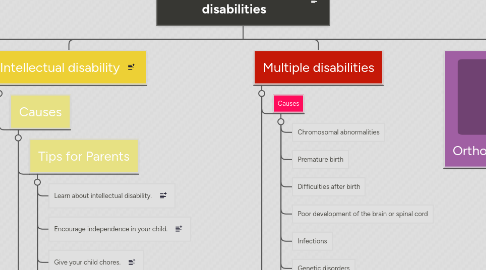
1. Autism Spectrum Disorders
1.1. the Characteristics
1.1.1. Communication problems
1.1.2. Difficulty relating to people, things, and events
1.1.3. Difficulty adjusting to changes in routine or to familiar surroundings
1.1.4. Repetititive body movements or behaviors
1.2. Tips for Parents
1.2.1. Learn about autism spectrum disorders
1.2.2. Be mindful
1.2.3. Learn from professionals and other parents
1.2.4. If you weren’t born loving highly structured, consistent schedules and routines
1.2.5. Learn about assistive technology
1.2.6. Work with professionals in early intervention or in your child’s school
1.2.7. Be patient and stay optimistic
1.3. Tips for Teachers
1.3.1. Learn more about the autism spectrum
1.3.2. Make sure directions are given step-by- step
1.3.3. Find out what the student’s strengths and interests are and emphasize them.
1.3.4. Build opportunities for the student to have social and collaborative interactions
1.3.5. Have consistent routines and schedules.
1.3.6. Work together with the student’s parents and other school personnel
1.4. Autism Spectrum Disorders
2. Deaf-blindness
2.1. Finding Help
2.1.1. Children birth to age 3
2.1.1.1. Early intervention services under the Infants and Toddlers with Disabilities program of IDEA
2.1.2. School-age children, including preschoolers
2.1.2.1. Special education services under Part B of IDEA
3. Deafness
3.1. Types of Hearing Loss
3.1.1. Conductive hearing losses
3.1.2. Sensorineural hearing losses
3.1.3. A mixed hearing loss
3.1.4. A central hearing loss
3.2. Finding Help
3.2.1. Early intervention
3.2.2. Special education and related services
4. Developmental delay
4.1. The developmental milestones.
4.1.1. The time-table for skills to emerge is commonly called the developmental milestones.
4.1.2. It’s when skills don’t emerge as expected, more or less on that broad schedule, that parents and caregivers may become concerned.
4.2. IDEA’s Definition of Developmental Delay
4.2.1. Who is experiencing developmental delays as defined by the State and as measured by appropriate diagnostic instruments and procedures in one or more of the following areas
4.2.1.1. Physical development
4.2.1.2. Cognitive development
4.2.1.3. Communication development
4.2.1.4. Social or emotional development
4.2.1.5. Adaptive development
4.2.2. Who, by reason thereof, needs special education and related services
4.3. Early intervention services
4.3.1. Assistive technology (devices a child might need)
4.3.2. Audiology or hearing services
4.3.3. Speech and language services
4.3.4. Counseling and training for a family
4.3.5. Medical services
4.3.6. Nursing services
4.3.7. Nutrition services
4.3.8. Occupational therapy
4.3.9. Physical therapy
4.3.10. Psychological services
4.4. Special education services
5. Emotional disturbance
5.1. Definition
5.2. Characteristics
5.2.1. Hyperactivity (short attention span, impulsiveness)
5.2.2. Aggression or self-injurious behavior (acting out, fighting)
5.2.3. Withdrawal (not interacting socially with others, excessive fear or anxiety)
5.2.4. Immaturity (inappropriate crying, temper tantrums, poor coping skills)
5.2.5. Learning difficulties (academically performing below grade level).
5.3. Causes
5.4. Frequency
5.5. Help for School-Aged Children
6. Hearing impairment
6.1. Types of Hearing Loss
6.1.1. Conductive hearing losses
6.1.2. Sensorineural hearing losses
6.1.3. A mixed hearing loss
6.1.4. A central hearing loss
6.2. Caroline’s Story
7. Intellectual disability
7.1. Causes
7.1.1. Tips for Parents
7.1.1.1. Learn about intellectual disability.
7.1.1.2. Encourage independence in your child.
7.1.1.3. Give your child chores.
7.1.1.4. Give your child frequent feedback.
7.1.1.5. Find out what skills your child is learning at school.
7.1.1.6. Find opportunities in your community for social activities,
7.1.1.7. Talk to other parents whose children have an intellectual disability.
7.1.1.8. Meet with the school and develop an IEP to address your child’s needs.
7.1.1.9. Take pleasure in your beautiful one.
7.1.2. Genetic conditions.
7.1.3. Problems during pregnancy.
7.1.4. Problems at birth.
7.1.5. Health problems.
7.2. Frequency
7.3. The Signs of Intellectual Disability
7.4. Diagnosis
7.4.1. Intellectual functioning
7.4.2. Adaptive behavior
8. Multiple disabilities
8.1. Causes
8.1.1. Chromosomal abnormalities
8.1.2. Premature birth
8.1.3. Difficulties after birth
8.1.4. Poor development of the brain or spinal cord
8.1.5. Infections
8.1.6. Genetic disorders
8.1.7. Injuries from accidents
8.2. To support, parent, or educate a child with multiple disabilities, it’s important to know:
8.2.1. which individual disabilities are involved;
8.2.2. how severe (or moderate or mild) each disability is; and
8.2.3. how each disability can affect learning and daily living.
8.3. Sharon’s Story
9. Orthopedic impairment
10. Other health impairment
10.1. Special Help for Children
10.1.1. Early intervention services
10.1.2. Special education and related services
11. Specific learning disability
11.1. Dyslexia—which refers to difficulties in reading
11.1.1. What Causes Dyslexia?
11.2. Dysgraphia—which refers to difficulties in writing
11.3. Dyscalcula—which refers to difficulties in math.
12. Speech or language impairment
12.1. Definition
12.2. Four major areas in which impairments occur
12.2.1. Articulation
12.2.2. Fluency
12.2.3. Voice
12.2.4. Language
12.3. Causes
13. Traumatic brain injury (TBI)
13.1. The Signs of Traumatic Brain Injury
13.1.1. Physical disabilities
13.1.2. Difficulties with thinking
13.1.3. Social, behavioral, or emotional problems
13.2. Help
13.2.1. To access early intervention
13.2.2. To access special education and related services
14. Visual impairment, including blindness
14.1. strabismus
14.2. congenital cataracts
14.3. retinopathy of prematurity
14.4. retinitis pigmentosa
14.5. coloboma
14.6. optic nerve hypoplasia
14.7. cortical visual impairment (CVI)
14.8. Case Studies
14.8.1. Early Intervention: Helping babies with visual impairments
